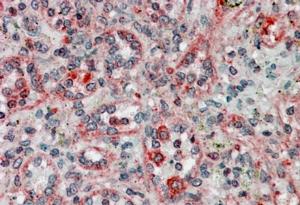Goat Anti-TXNDC1 / TMX Antibody
Peptide-affinity purified goat antibody
- SPECIFICATION
- CITATIONS
- PROTOCOLS
- BACKGROUND

Application
| WB, IHC, E |
|---|---|
| Primary Accession | Q9H3N1 |
| Other Accession | NP_110382, 81542 |
| Reactivity | Human |
| Host | Goat |
| Clonality | Polyclonal |
| Concentration | 100ug/200ul |
| Isotype | IgG |
| Calculated MW | 31791 Da |
| Gene ID | 81542 |
|---|---|
| Other Names | Thioredoxin-related transmembrane protein 1, Thioredoxin domain-containing protein 1, Transmembrane Trx-related protein, TMX1, TMX, TXNDC, TXNDC1 |
| Dilution | WB~~1:1000 IHC~~1:100~500 E~~N/A |
| Format | 0.5 mg IgG/ml in Tris saline (20mM Tris pH7.3, 150mM NaCl), 0.02% sodium azide, with 0.5% bovine serum albumin |
| Storage | Maintain refrigerated at 2-8°C for up to 6 months. For long term storage store at -20°C in small aliquots to prevent freeze-thaw cycles. |
| Precautions | Goat Anti-TXNDC1 / TMX Antibody is for research use only and not for use in diagnostic or therapeutic procedures. |
| Name | TMX1 {ECO:0000303|PubMed:37648867, ECO:0000312|HGNC:HGNC:15487} |
|---|---|
| Function | Thiredoxin domain-containing protein that participates in various redox reactions through the reversible oxidation of its active center dithiol to a disulfide and catalyze dithiol-disulfide exchange reactions (PubMed:11152479, PubMed:37648867). Acts as a key inhibitor of the alternative triglyceride biosynthesis pathway by inhibiting the activity of TMEM68/DIESL at the endoplasmic reticulum, thereby restricting accumulation of triacylglycerol (PubMed:37648867). The alternative triglyceride biosynthesis pathway mediates formation of triacylglycerol from diacylglycerol and membrane phospholipids (PubMed:37648867). Acts as a protein disulfide isomerase by catalyzing formation or reduction of disulfide bonds (PubMed:22228764, PubMed:29932915). Specifically mediates formation of disulfide bonds of transmembrane proteins at the endoplasmic reticulum membrane (PubMed:22228764). Involved in endoplasmic reticulum-associated degradation (ERAD) via its protein disulfide isomerase activity by acting on folding-defective polypeptides at the endoplasmic reticulum membrane (PubMed:29932915). Acts as a negative regulator of platelet aggregation following secretion in the extracellular space (PubMed:30425049). Acts as a regulator of endoplasmic reticulum- mitochondria contact sites via its ability to regulate redox signals (PubMed:27502484, PubMed:31304984). Regulates endoplasmic reticulum- mitochondria Ca(2+) flux (PubMed:27502484). |
| Cellular Location | Endoplasmic reticulum membrane; Single-pass type I membrane protein. Mitochondrion membrane; Single-pass type I membrane protein. Secreted. Note=Predominantly found in the endoplasmic reticulum (PubMed:11152479). Secreted in the extracellular space following thrombin stimulation (PubMed:30425049). Localizes to mitochondria-associated endoplasmic reticulum membrane (MAM); palmitoylation is required for MAM localization (PubMed:22045338, PubMed:27502484, PubMed:31304984). |
| Tissue Location | Ubiquitous (PubMed:11152479). Highly expressed in kidney, liver, placenta and lung (PubMed:11152479) |

Thousands of laboratories across the world have published research that depended on the performance of antibodies from Abcepta to advance their research. Check out links to articles that cite our products in major peer-reviewed journals, organized by research category.
info@abcepta.com, and receive a free "I Love Antibodies" mug.
Provided below are standard protocols that you may find useful for product applications.
Background
TXNDC1 is a thioredoxin (TXN; see MIM 187700)-related protein with disulfide reductase activity (Matsuo et al., 2001 [PubMed 11152479]).
References
Physical and functional interaction of transmembrane thioredoxin-related protein with major histocompatibility complex class I heavy chain: redox-based protein quality control and its potential relevance to immune responses. Matsuo Y, et al. Mol Biol Cell, 2009 Nov. PMID 19741092.
Toward a confocal subcellular atlas of the human proteome. Barbe L, et al. Mol Cell Proteomics, 2008 Mar. PMID 18029348.
Global, in vivo, and site-specific phosphorylation dynamics in signaling networks. Olsen JV, et al. Cell, 2006 Nov 3. PMID 17081983.
Diversification of transcriptional modulation: large-scale identification and characterization of putative alternative promoters of human genes. Kimura K, et al. Genome Res, 2006 Jan. PMID 16344560.
Signal sequence and keyword trap in silico for selection of full-length human cDNAs encoding secretion or membrane proteins from oligo-capped cDNA libraries. Otsuki T, et al. DNA Res, 2005. PMID 16303743.
If you have used an Abcepta product and would like to share how it has performed, please click on the "Submit Review" button and provide the requested information. Our staff will examine and post your review and contact you if needed.
If you have any additional inquiries please email technical services at tech@abcepta.com.













 Foundational characteristics of cancer include proliferation, angiogenesis, migration, evasion of apoptosis, and cellular immortality. Find key markers for these cellular processes and antibodies to detect them.
Foundational characteristics of cancer include proliferation, angiogenesis, migration, evasion of apoptosis, and cellular immortality. Find key markers for these cellular processes and antibodies to detect them. The SUMOplot™ Analysis Program predicts and scores sumoylation sites in your protein. SUMOylation is a post-translational modification involved in various cellular processes, such as nuclear-cytosolic transport, transcriptional regulation, apoptosis, protein stability, response to stress, and progression through the cell cycle.
The SUMOplot™ Analysis Program predicts and scores sumoylation sites in your protein. SUMOylation is a post-translational modification involved in various cellular processes, such as nuclear-cytosolic transport, transcriptional regulation, apoptosis, protein stability, response to stress, and progression through the cell cycle. The Autophagy Receptor Motif Plotter predicts and scores autophagy receptor binding sites in your protein. Identifying proteins connected to this pathway is critical to understanding the role of autophagy in physiological as well as pathological processes such as development, differentiation, neurodegenerative diseases, stress, infection, and cancer.
The Autophagy Receptor Motif Plotter predicts and scores autophagy receptor binding sites in your protein. Identifying proteins connected to this pathway is critical to understanding the role of autophagy in physiological as well as pathological processes such as development, differentiation, neurodegenerative diseases, stress, infection, and cancer.



